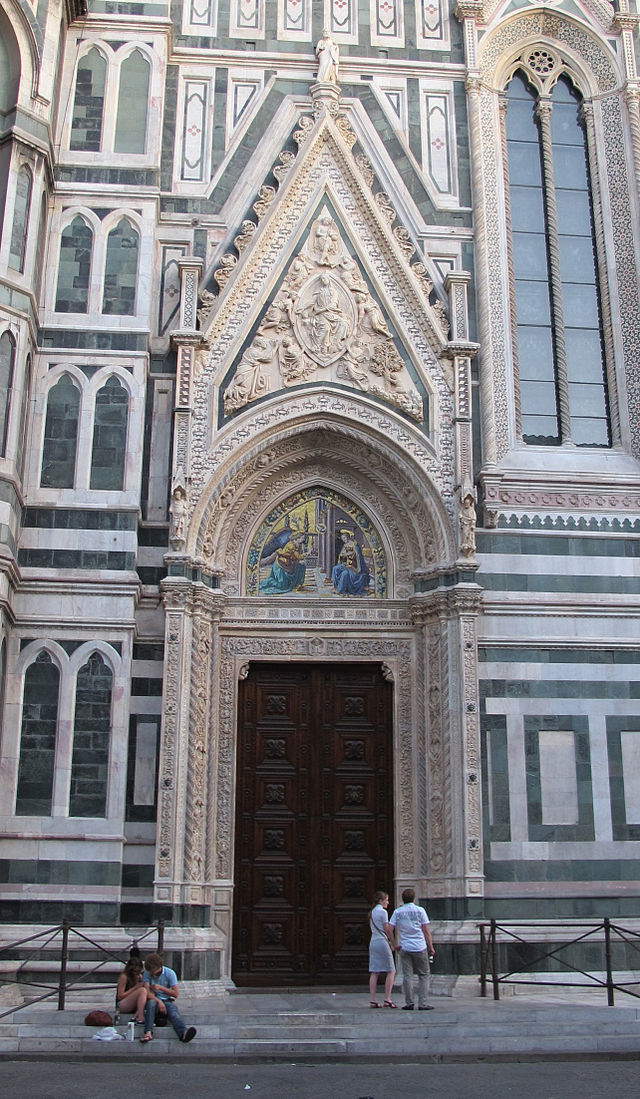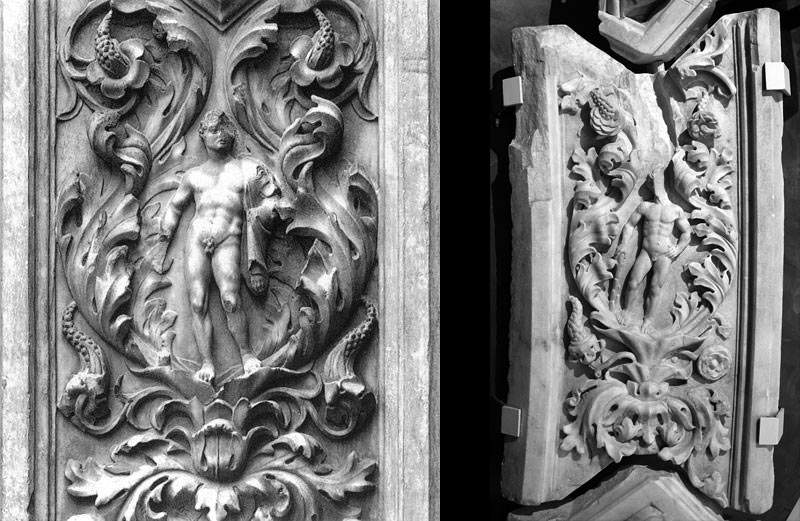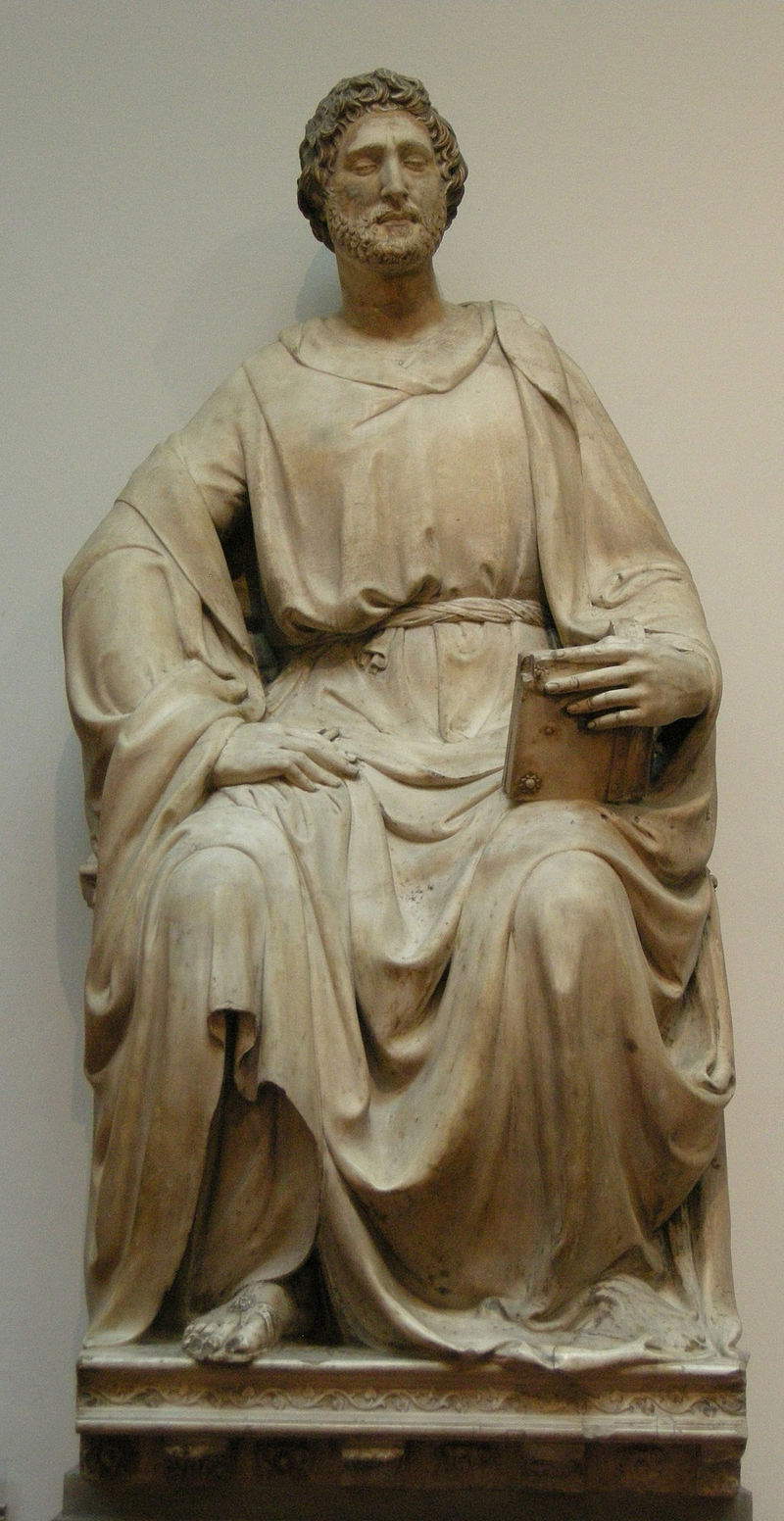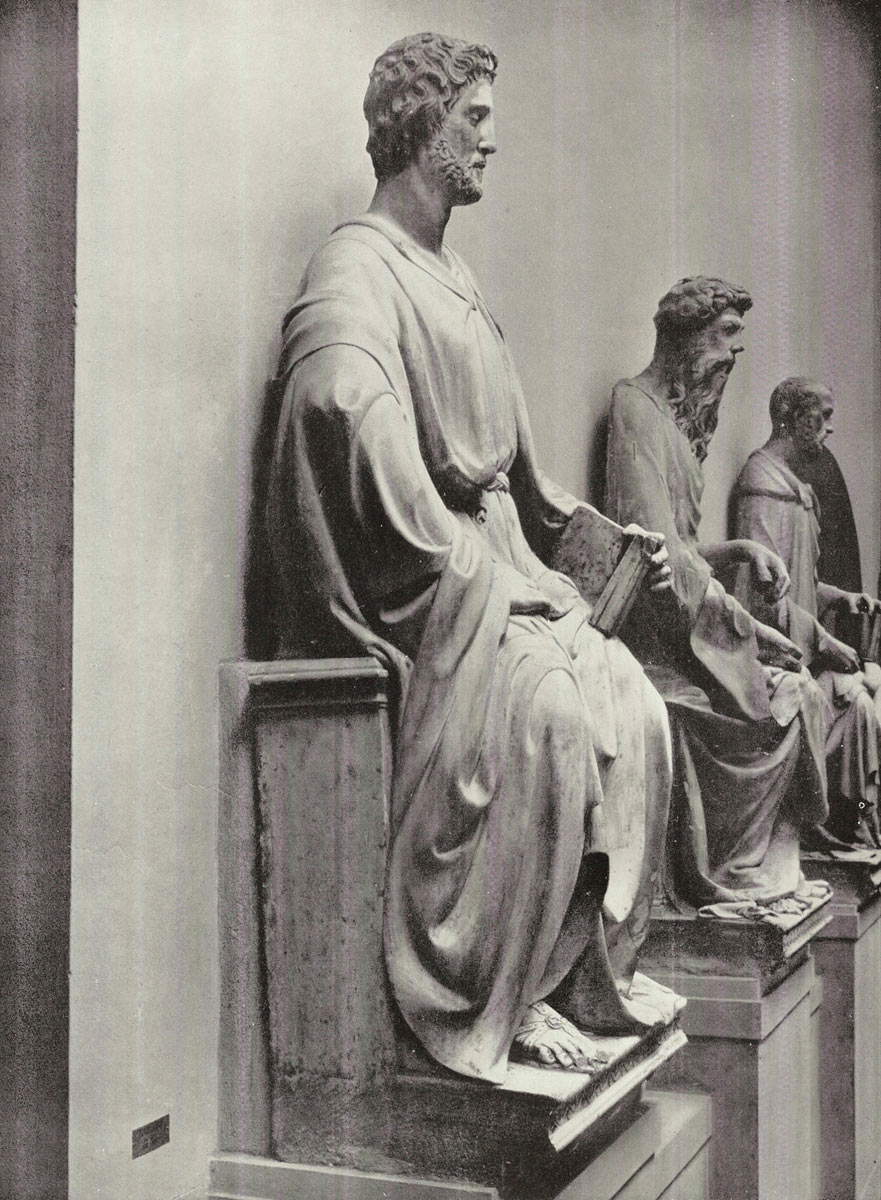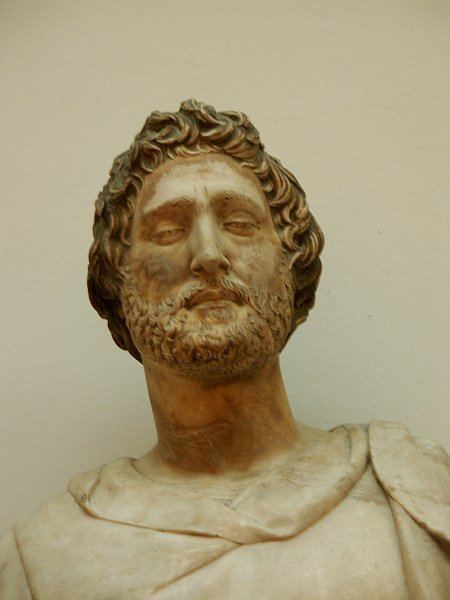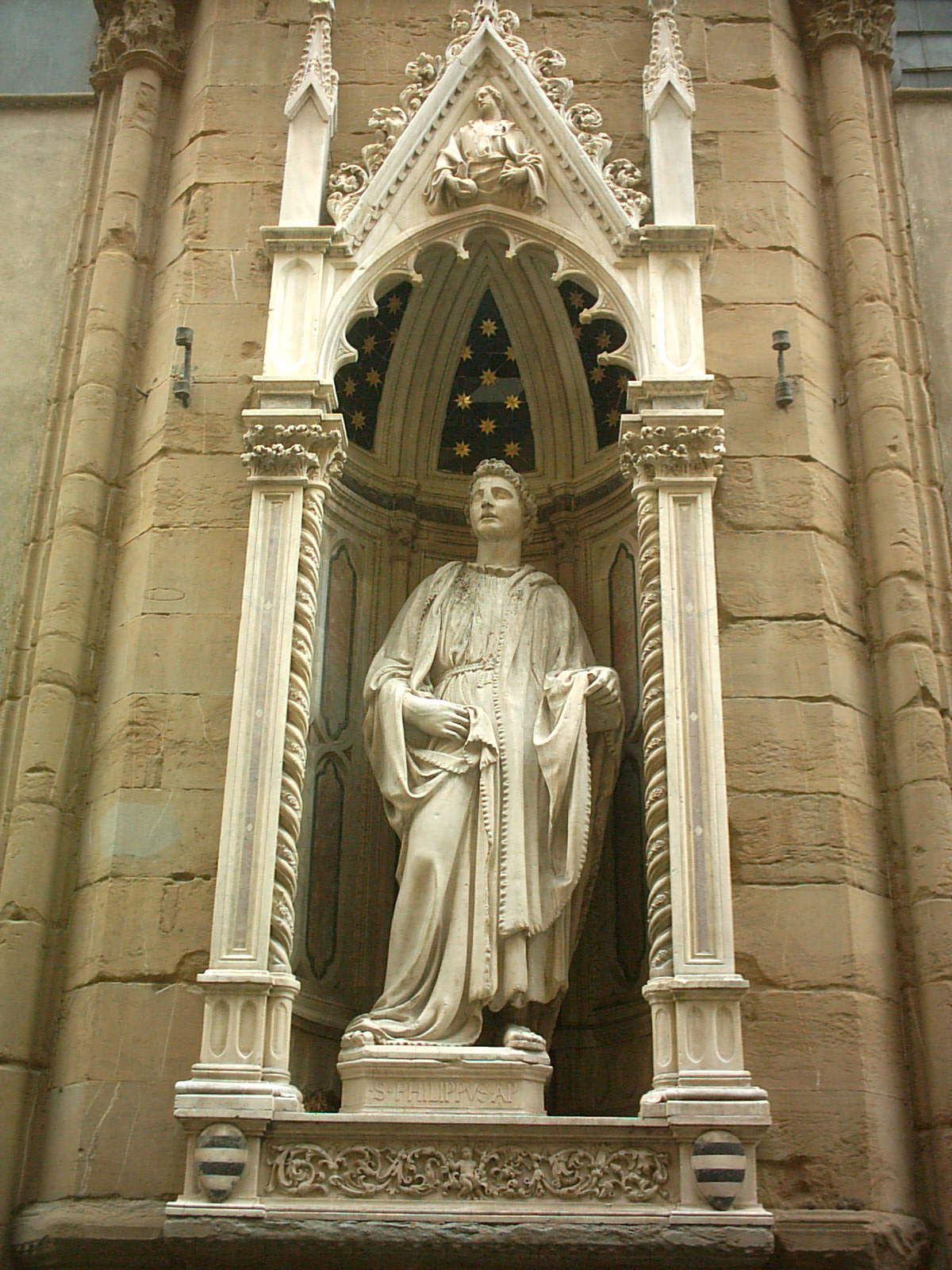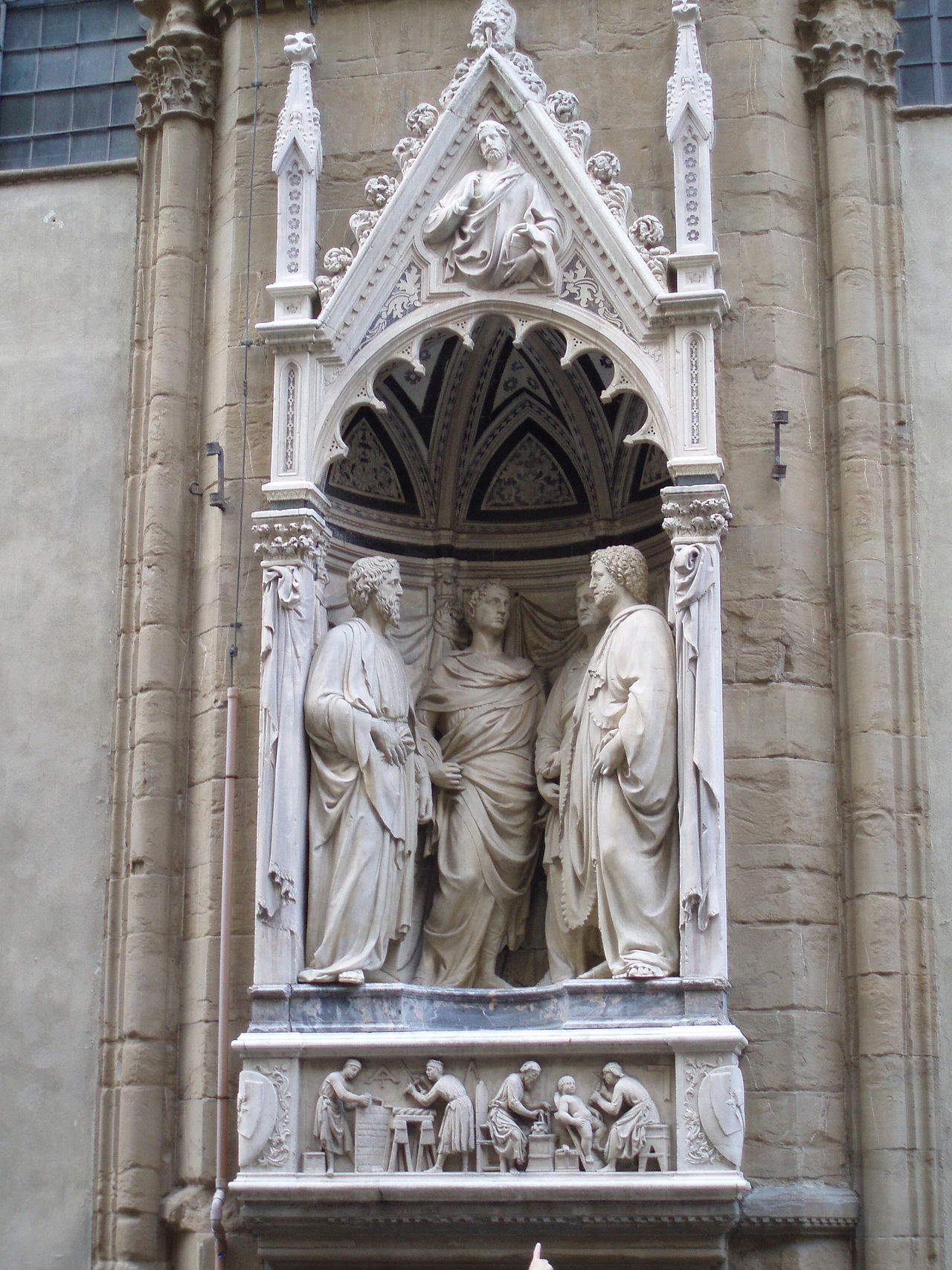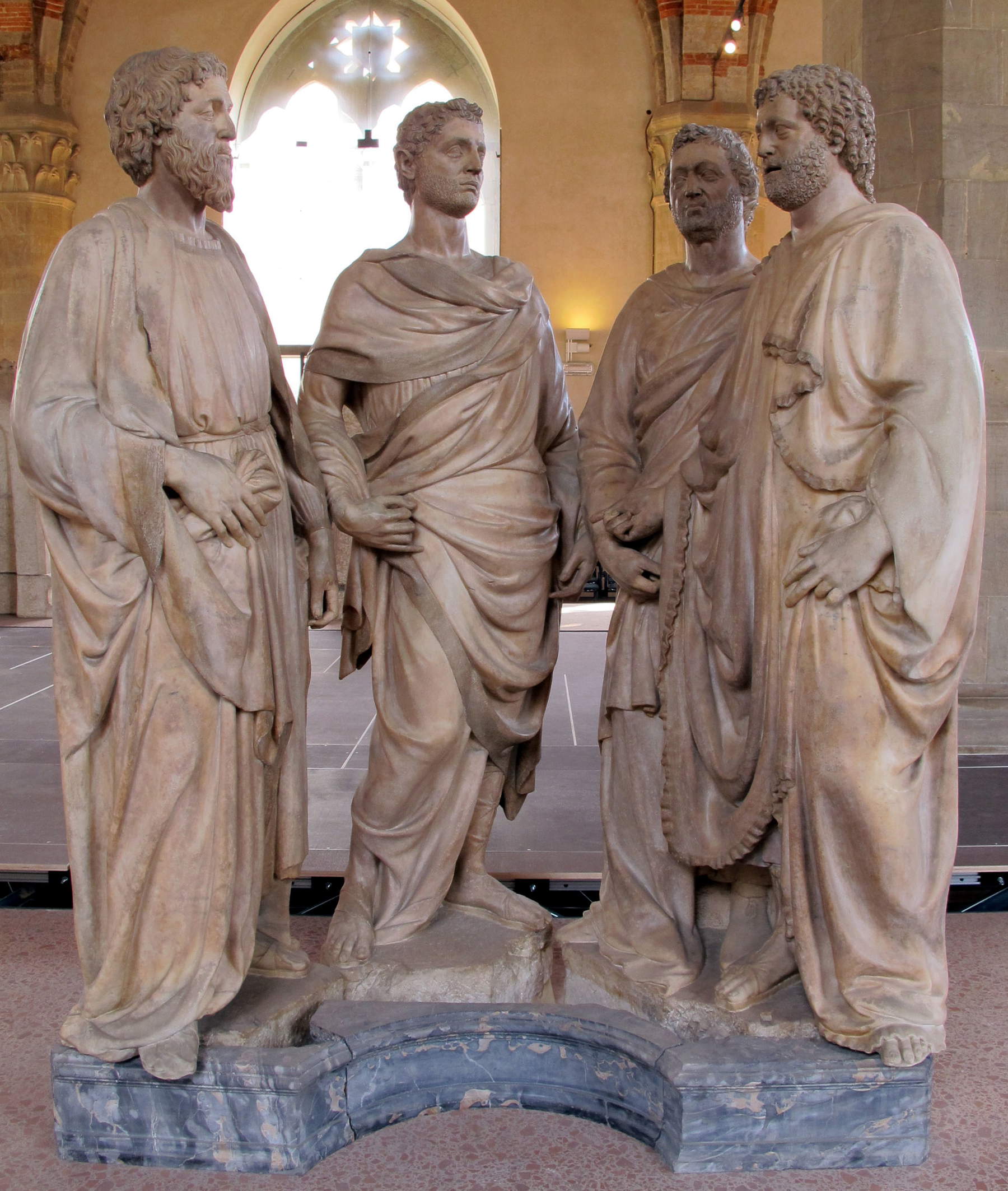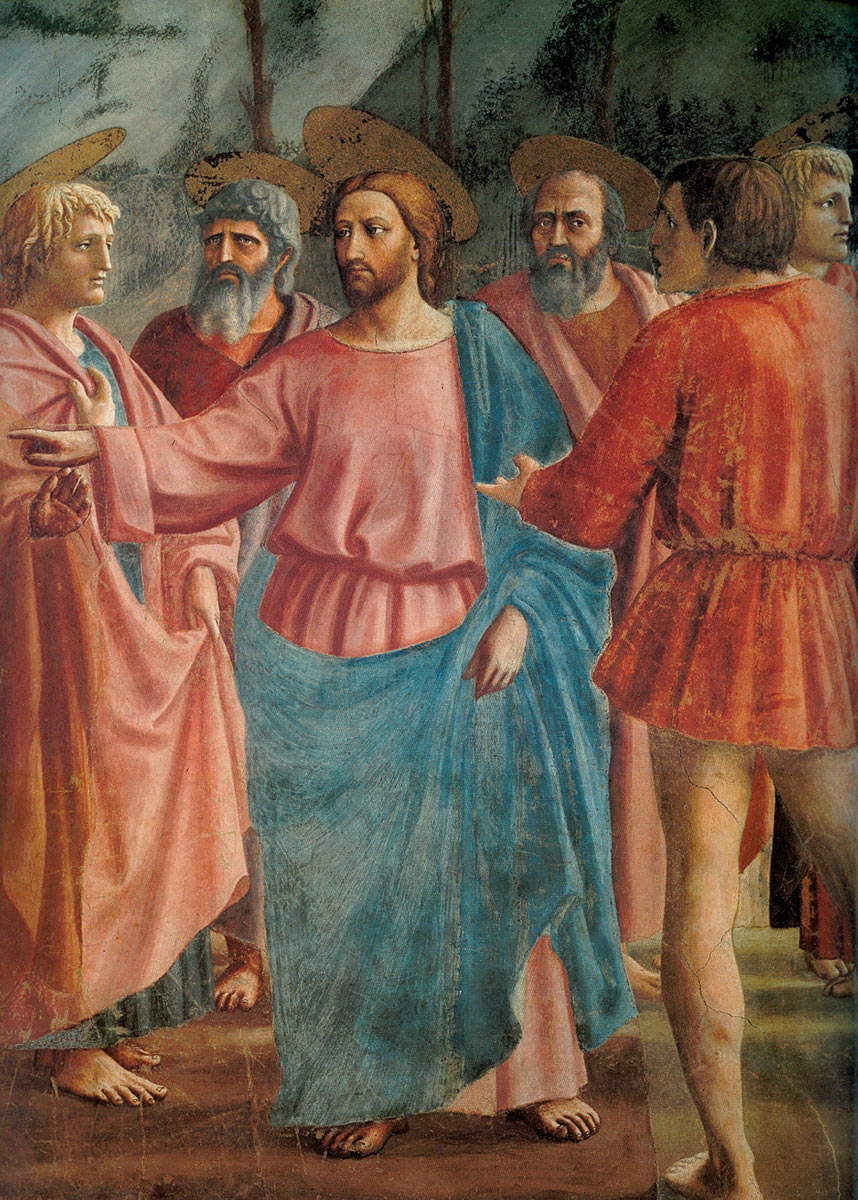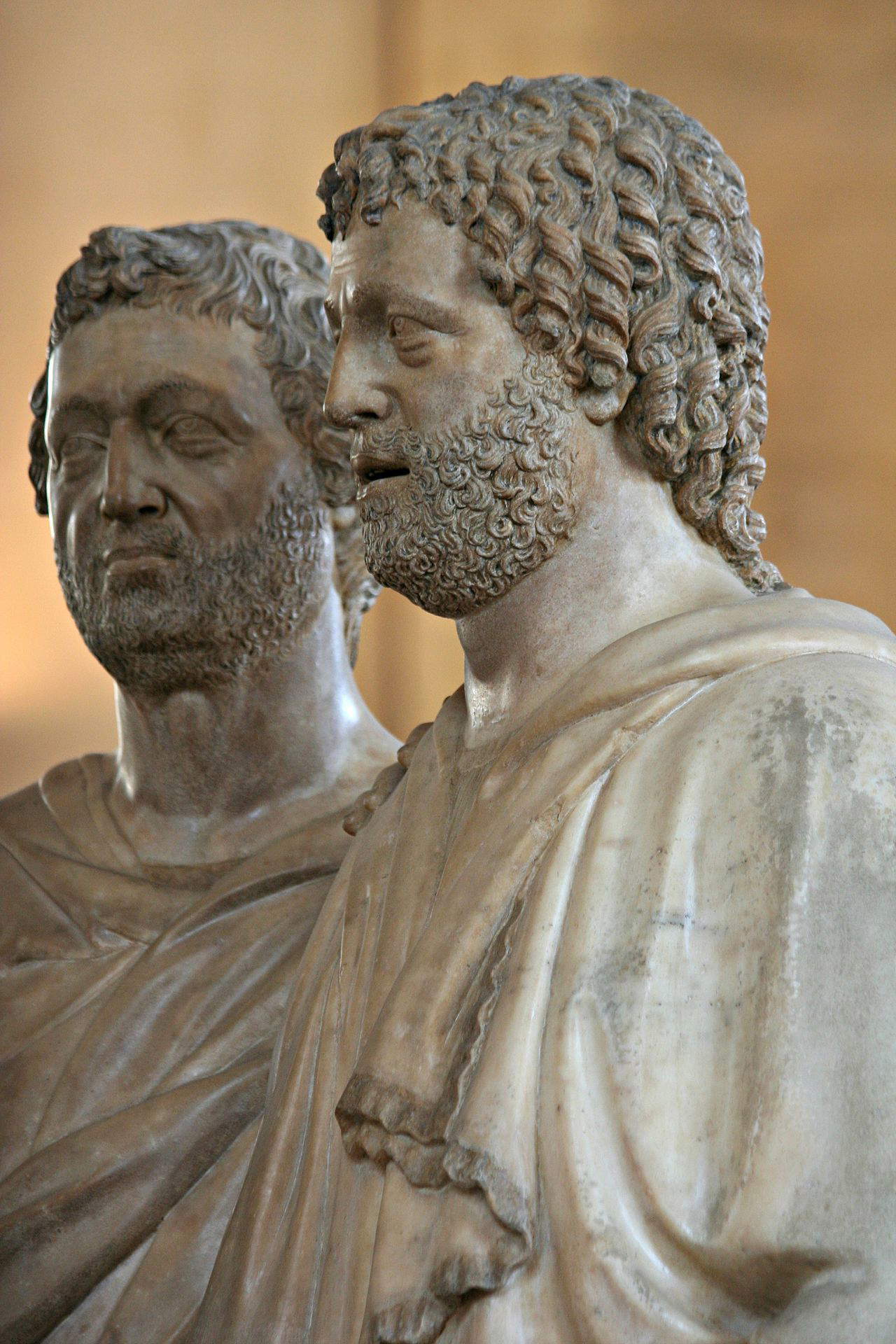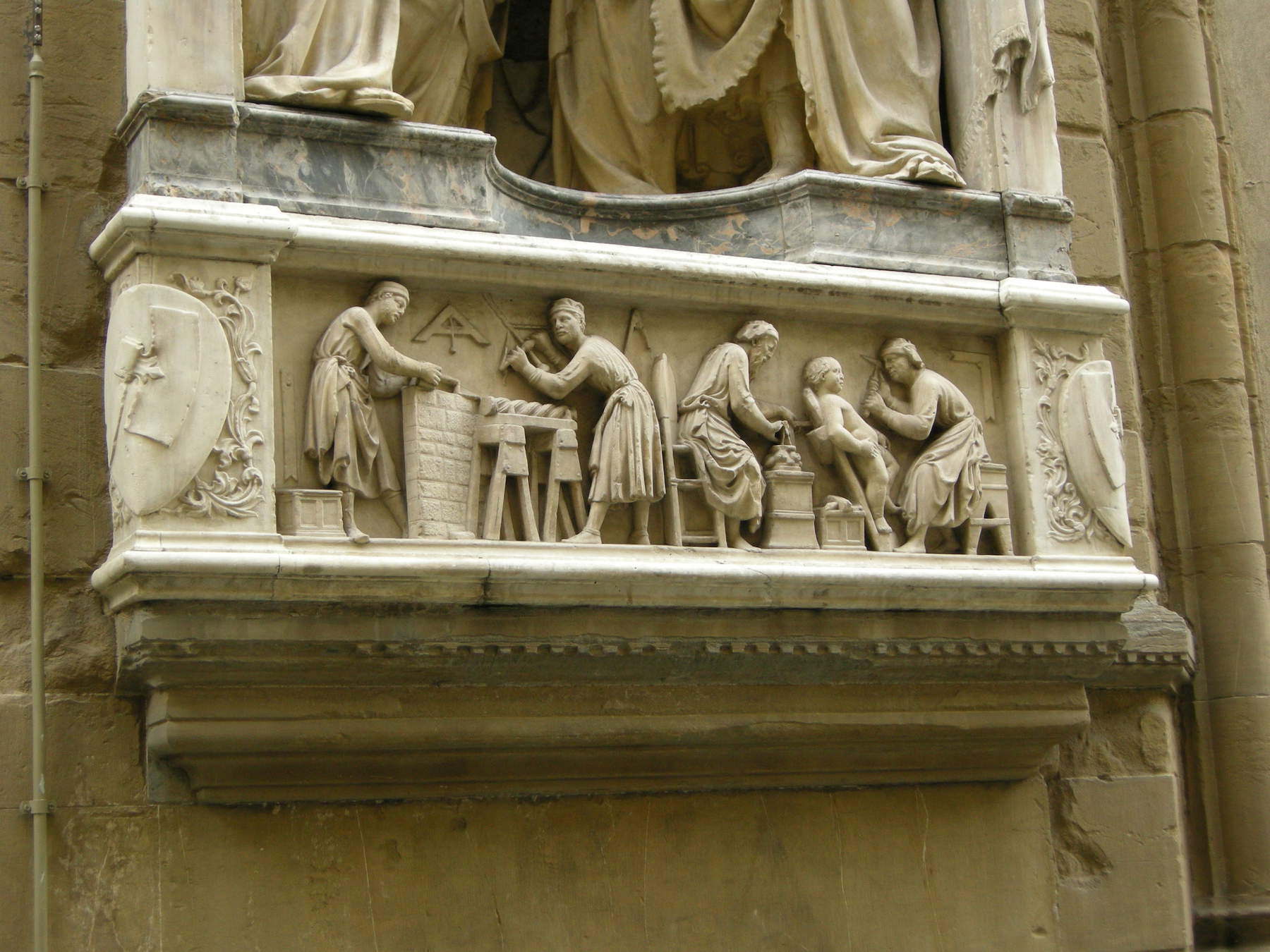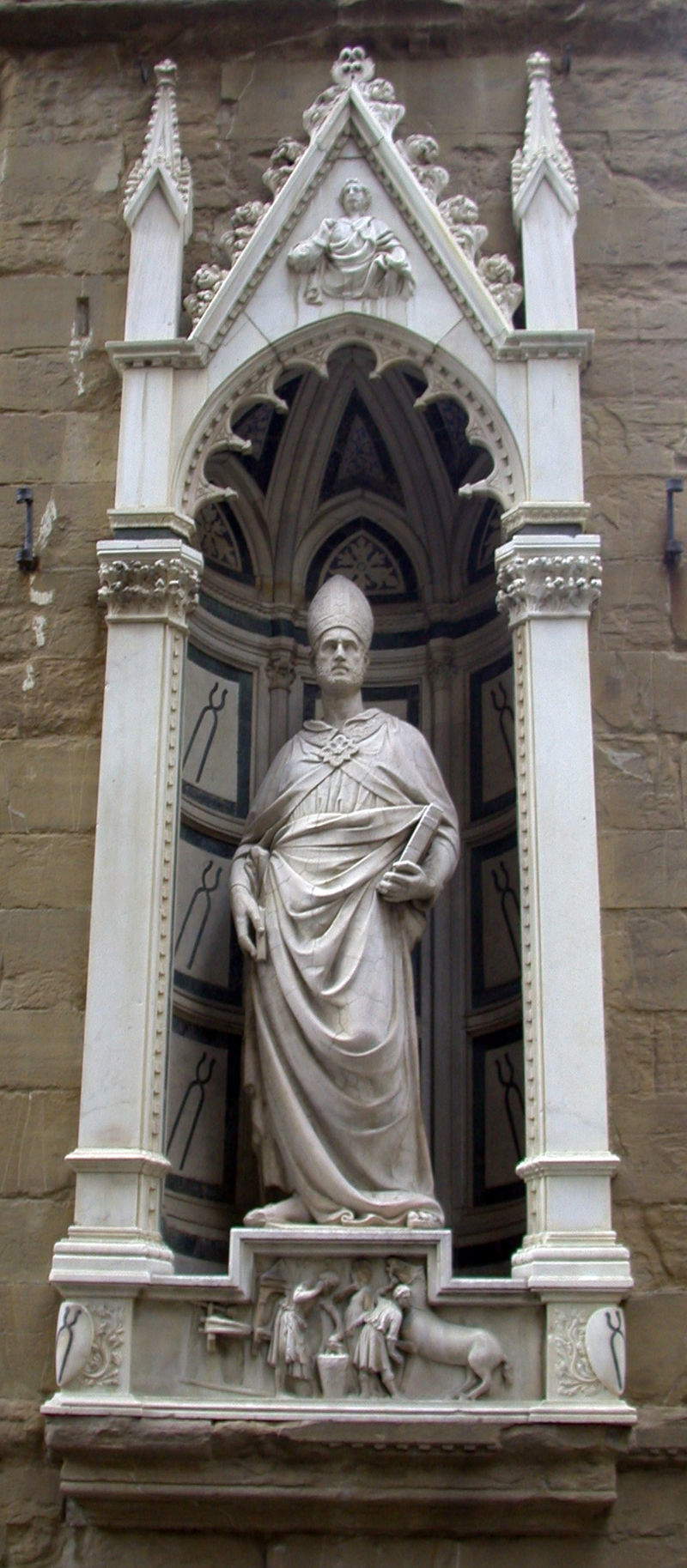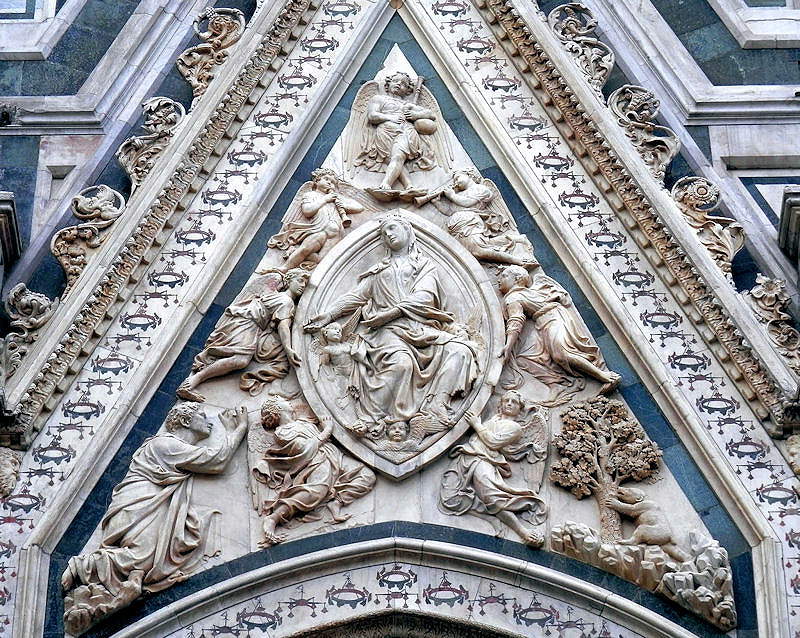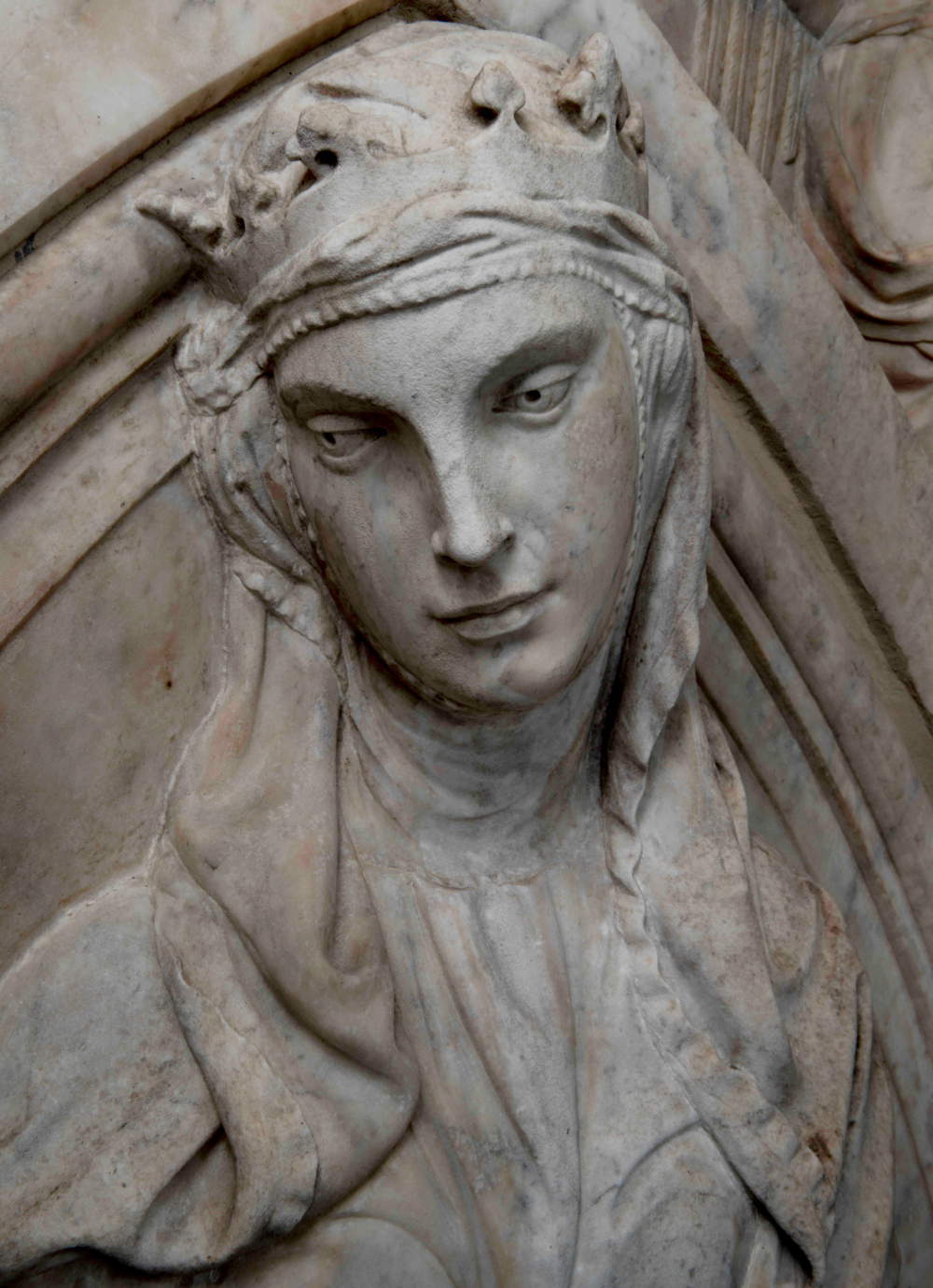by Giuseppe Adani , published on 22/06/2020
Categories: Works and artists
/ Disclaimer
Along with Filippo Brunelleschi, Lorenzo Ghiberti and Donatello, Nanni di Banco can be considered one of the fathers of Renaissance sculpture. A journey through his wonderful masterpieces.
Why Nanni? Because without him the dawn of the Renaissance would lack a most splendid light. Because it is necessary to rebalance the knowledge of the true roots of the Renaissance itself. Because next year will run the sixth centenary of his death and Florence will have to dedicate the whole year to him, and an intense preparation is needed from now on, at true popular amplitude, so that every Italian and every visitor can be pervaded by the leavening and indelible joy of knowing him. An exhibition will not be necessary since all of his works, sculptural, can be found within a radius of two hundred meters in the city, but in-depth studies are indispensable. What is more, now runs the historical moment in which (following heartfelt pleas of the past decades) almost all of Nanni’s works have received adequate and luminous restoration, beginning with the truly triumphant restoration of the Almond Door of Florence Cathedral. We recall that Ilaria Baratta and Federico Giannini had already devoted special attention to this Father of the Renaissance. Here we now place a contribution that is a small story, but also a meditation that we hope will be useful.
Nanni had married his Nanna, and the two young people loved each other, but a mysterious illness kidnapped the enlightened artist in February 1421, when he was just past his thirties. He was heartily buried the Santa Croce, there where the beloved and deserving men of the city of the Flower rest. In a small tombstone he told us briefly about himself: “Sculptor eram excellens claris natalibus ortus - me prohibet de me dicere plura pudor” (I was an excellent sculptor, born of clear family, restraint forbids me to say many things about myself).
Of his grandfather, who bore the bold name of Banco Falco, we know very little, but he was perhaps already a distinguished citizen. Of his father Antonio we know that he was above all an entrepreneur of marble works and probably a stone worker himself: he was several times consul of the Arte dei Maestri di Pietra e Legname, and on April 11, 1414, he came to be elected master builder of the Opera del Duomo. Nanni therefore came into the light among resounding bundles and copper hammers, among chisels and marble splinters, probably in 1390 or well before, and at the age of six he entered the workshop according to the custom of the time (bottega as iscuola was called in Tuscany): there he sucked up the trade with eyes and hands (tu ’à da rubar con gli occhi, was the maxim for garzoncelli). He found himself among trestles and trestle stands, among sixths and croceras, among archers and dummies, among bocciarde and drill violins; he learned to beat the earth, to set the figures, to climb on the balchi to weigh the “weights” of the free figures; then to set the brasses for the casts and to cast the plasters; finally to wet the blocks of marble on all sides to abduct the veins and leanings, and together to understand the depths of the dents of the points and gradines; to scapucciare the edges and to place the thick lunge of the subbie according to the enveloping course of the modeling. He became adept at tempering irons at the forge for gentler and sharper cuts; he caught all the grains of surface finishes, between buffs and rasps. He made the ever-present callus at the root of the little finger of his left hand, a seal of mastery.
In February 1405 he was matriculated in his father’s art, with oath, and this confronts us with an early maturity, certainly extraordinary in itself but not unique and highly significant. Two things the documentary sources do not tell us, but are revealed to us by the works: his exceptional vocation as a “statuary” and his cultural training, which must have been high, of equal standing. With regard to the latter we must think of a profound capacity for judgment on the works of classical antiquity, and on the more recent works of the magnificent pre-humanistic school of Pisa, and also of Jacopo della Quercia. An education that included strong biblical-religious meditation, anatomical study of genuine novelty and naturalness, travels of knowledge, and acute selective faculty in the observant play of continuous formal comparisons.
If the Fathers of the Renaissance are rightly considered “geniuses of art,” Nanni is rightly included among them. So let us recall the names of the three companions he had on the road of his youth: Filippo Brunelleschi (Florence, 1377 - 1446), Lorenzo Ghiberti (Pelago, 1378 - Florence, 1455), Donatello dei Bardi (Florence, 1386 - 1466). We are in front of four Fathers, four sculptors, each with a specific personality but all endowed with that inseparable over-vocation to conceive the complexes inherent in sculpture (the facades, doors, altars, chapels, tabernacles, pulpits, etc.). A formidable group that looked to the ancient and simultaneously chose, with a very modern spirit, the “portrayal of the natural.” Filippo of preference ruminated on building forms and ocular perceptions; Lorenzo immersed himself in an extreme sweetness of extraordinary communicative capacity; Donato was shaken by his restlessness that gave him break-ins and masterpieces. Nanni (the youngest, possessed of an admirable strength) pinned himself primarily on the lone figure and marble, on the body filled with life: the Man!
We must give a quick existential and working picture of Nanni. His registration could be done at the age of fifteen, and this can be recognized from the documents; he continued to work with his father and the many employees of the firm, always needed to deal with the marble blocks. His hand and works soon stood out. We have few notes on commissions, and this has given rise to sometimes too many different dates on the same figures by scholars: we would almost call this a sign of recognition, at least, on the consistency of style in Nanni’s continuity. His entire performing corpus remains in the fifteen years between 1406 and 1421. He was a very socially active person, and several times Consul of the Art of Stone Masters. He held civic offices of serious importance: he was repeatedly elected podestà in some of the outer centers of the Florentine Republic; he held the position of “officer of the night” in the city and even entered among “the sixteen” who were the Gonfalonieri di Compagnia (of great authority, say the ancient Statutes). He received public esteem and was able to give economic guarantees for Donatello, his friend. His collaboration with Brunelleschi on the model of the dome of the Duomo is documented, with relative reward; news of this that assures him of the highest welcome in that “renovatio” which Florence was elaborating in the sight of the world. His early death prevented his development of works and fame: the few marble masterpieces remain of him.
He engaged in two phases on the solemn Porta della Mandorla, his father’s long structural work on the left flank of the Duomo, facing the arrival of the most typical pilgrim route: in his very early youth, and then in the years of full activity. While his father was developing the sguinci, or salient jambs of the monumental work, Nanni got his hand into the decorative carvings (decorative yes, but as significant in a creaturely and historical sense) so virenti and tactile, and in them he dared with pungent naturalness to insert among the other figures the mnemonic presence of Hellenic heroism (Heracles several times) as a testimony to the “time of waiting” in the high and classical affair of the “Gentile” peoples.
With the following figures we are in the first phase (years 1406 - 1407). We catch first the general view of the Door, and then the details of the frieze, and finally the famous Profetinus, who was matched by a similar, more collected figure by Donatello (now both in the Duomo Museum).
 |
| Florence, Porta della Mandorla on the left flank of the Duomo, formerly a busy access to Santa Maria del Fiore in front of what is now Via Ricasoli, an ancient pilgrim route. Insignificant marble work by Antonio di Banco and his son Nanni (1391 - 1423). The view demonstrates the recent restoration, supervised mainly by Msgr. Timothy Verdon. On the pillars beside the ghimberga are missing the two prophets, now kept in the Museo dell’Opera del Duomo. |
 |
| These two figures of Hercules, now kept in the Museum, testify to the fullness of the classical assumption in Nanni’s training and soul. They are the first magnificent standard set early on to illuminate the volitional acerbity of the Italian Renaissance. |
 |
| Nanni, Back Nude in the friezes of the Almond Gate. An astonishing and almost unbelievable version of the soft side of the male body (perhaps an Asclepius, god of healings, with his serpent) that, on the edge of the medieval occasional, restores to us the sensual sweetnesses of serene Hellenism. |
 |
| Christ in Pity (or Man of Sorrows) at the top of the frieze of the Almond Gate. Stunning figure that marks the immediate harmonious achievement of anatomy in relief. Here Nanni truly opens the Renaissance. From these works we can learn how Brunelleschi wanted to bond with his friend for his ideal and structural research. |
 |
| The Profetini of the Almond Door (1404 - 1407). These are the famous door openers of the Renaissance in Florence, now preserved in the Museo del Duomo. First moving accomplishment of the two very young friends. The one on the left is credited to Donatello, the one on the right unanimously to Nanni: both revealing the vocation to “complete sculpture,” i.e., statue. In fact, the lone, standing marble figure is, for the new men of the renaissance, the compendious concentration of every expressible virtue, and, at the same time, the dominion of the surrounding space, its conceptual qualification. Nanni’s prophetine adheres with intimate majesty on the lofty pillar, a sign of unmerited possession of God’s voice. Its composition is perfect: it begins innervated like a growing sapling, propelling itself from the left foot and twirling with measured firmness, and concludes in a dynamic, sublime axiality. The whole is balanced by the limbs and drapery. Here is the God-sent, the inspired, the serene prophet! His friend Donatello, a few years later would choose for his famous St. George at Orsanmichele, the precise posture of this absolute prototype. |
Let us now see the three large statuary figures that were requested from Nanni immediately after his first engagement at the Almond. It is important and significant to see how on January 24, 1408 by the Workmen of the Duomo Nanni is designated as the author of theIsaiah to be placed on the spurs of the northern tribune, thus in the open air, at the top, and how a month later Donatello is approached “under the same conditions as Maestro Nanni” for the inconvenient David that now stands at the Bargello. Even the Isaiah, finished in December of the same year, will not reach the sproni but will be placed in the Duomo.
On December 19, 1408, the same Workers deliberated on the execution of three Evangelists for the facade of the Duomo, assigned to Nanni, Donatello and Nicolò di Pietro Lamberti: the fourth would be reserved as a prize for the best of the three. It did not turn out that way and we avoid following the intricate story. Nanni finished his San Luca at the end of 1412 while Donatello, more listless and repeatedly solicited, delivered the San Giovanni two and a half years later. This was a second confrontation between the two friends, following that of the Almond prophets.
The image of St. Philip was inserted as a commission of the Shoemakers’ Art and was an opportunity for Nanni to identify with the spirit of that apostle who, in mystical rapture, asked Jesus if he could see the Father. Vasari himself, though prone to chronological digressions, noted the “good grace and vividness in the head.” It was a matter for the sculptor to give an intense motion of spirit to a figure of monumental destination: the first that had to appear for him in an official tabernacle on the exterior of Orsanmichele. And it was not a forgettable ordeal, from the delightful cherub of the frieze at the base of the Tabernacle to the extraordinary Creator of the ghimberga: two precocious, stark images, such as to fill the heart at the dawn of the Italian Renaissance.
 |
| Nanni di Banco, Saint Isaiah, detail of the head (1408; Florence, Duomo, right aisle). This was a difficult task that had to take into account the considerable height over the void for which the statue was intended: a massive and powerful figure then, but one that was also moved to play with the strong light. Indeed, it appears to have been placed on the spurs of the tribune, but then withdrawn to the ground. The ideal confrontation that Nanni had was with the greatest prophet in divine history, and how to draw it from marble; the sculptor focused above all on the intensity of the face, which we show here, and wanted him tense in the premency of God’s message to be proclaimed, and with his eye fixed on the bewilderments of the world. Here is his impressive profile. |
 |
| Michelangelo, David, detail of head in profile (1501-1504; Florence, Galleria dell’Accademia). The young Buonarroti, who knew the entire Divine Comedy by heart, had equally equipped himself with a resounding figurative culture, incisive and selective to the highest degree. With certainty he had looked to Nanni as an ideal master. And here is the profile of the David, not unmindful of the absolute posing of the ancient Isaiah. |
 |
| Nanni, St. Luke (1409-1412). This is the first great monument of the Italian Renaissance. Solemn, broad, perfect figure, total symbol of the new conception of the earthly person as formed in the forerunner group of humanism. Nanni was its radiant interpreter. The Evangelist, scribe mansuetudinis Dei, is fully aware of his mission, serene in his unforgettable countenance. He has nothing more than the forbidding Gothic trappings, beards and curls. He is essentially thought! |
 |
| St. Luke by Nanni and St. John the Evangelist by Donatello. The photographic shot predates the present arrangement and defines some aspects. Each sculptor was given a marble block 205 cm. high but only 52 cm. thick. A most notable difficulty in this relationship, especially since the prophets were to appear full-length and seated. Nanni fully defines each part, while Donatello cuts off the shoulders of his St. John, bends him forward, and encrusts him in his apocalyptic figures; thus he must unnaturally hold his beard diagonally. Here Nanni is fully masterful! |
 |
| The head and face of St. Luke. A masterpiece held high and isolated, taken stupendously from the cànone of Lysippus. Here the Man of God is also the cólto rètore latino, and he is the Florentine protagonist of the new, radiant civil age. |
 |
| Nanni, Saint Philip (1409 - 1411; Florence, Tabernacle of Orsanmichele). Between 1408 and 1409 Nanni received the double commission of the Tabernacle of the Crowned Saints and the San Filippo: he finished the latter first for the Arte dei Calzaioli, and in this image we can see the artist’s work entirely: from that unspeakable, tender cherub of the base frieze to the splendid eternal figure of the ghimberga. The saint corresponds stupendously to what John writes in his gospel (14:8), when Philip, moved by desire asks Jesus, “Show us the Father.” Leonardo, in his drawings and in the Last Supper will perfectly capture such rapture of the soul, which Nanni sublimely expresses here. |
To the Tabernacle of the Four Crowned Saints we owe special reflection: it was an exceptional commission because of the size of the work (the largest tabernacle in Orsanmichele, housing as many as four full-length figures) and because of the significant choice of Nanni as the author by his own guild, that of the Art of the Masters of Stone and Lumber, who wanted their patron saints, martyrs, in it. But above the other very noble works, all of them religious, here Nanni exhibited a powerful thought that transcended the simple celebration of the patron saints; in fact, he conceived the supreme value of spiritual solidarity and committed himself figuratively to the affirmation of the concept of unity in the church and human society.
 |
| Nanni, Tabernacle of the Masters of Stone and Timber (1408 - 1413; Florence, Orsanmichele). The Tabernacle becomes almost a chapel, a spacious aedicula of courtly character, adorned on the jambs and all the walls by imperial drapery: a signal of the highest honor. The Vetero-Classical mentality of this father of the Renaissance stretches there, which imposes itself all the more in the illiberated majesty of the sculpted Saints who refused by faith to serve pagan idols. |
 |
| The Four Crowned Saints after restoration (Florence, Museo di Orsanmichele). The Roman firmitas of the witnesses of the Gospel totally stands out in the conversation that welds their minds into an unfailing unity. Here is a cenacle of spirits! This is the monumental wonder of the ineunte new season of art. At the edge of the first decade of the fifteenth century, the power of Nanni’s statuary manifesto pours powerfully into the group, precisely, of novi homines who accompany it. |
 |
| The dome of Santa Maria del Fiore, Florence (1420-1436). We see it as sinus Virginis, as a statution of the unity of the Church. It is compelling to think that Nanni contributed from the beginning to the design of this dome. |
 |
| Masaccio, the Tribute Scene, detail (1424-1427; Florence, Brancacci Chapel at the Carmine). Here the Apostles, signifiers to the Church, circle around Christ as ideally do the Four Crowned Saints. Masaccio’s take on Nanni is evident and emblematic, with equal historical impetus. |
 |
| Detail of the faces of the Protectors of the Stone Masters. Nanni’s ethical might is embodied in the monumental forms of full spiritual virtue, where the saints convenerunt in unum! An achievement that stands as pivotal in the artistic presence of all times. |
 |
| Base frieze of the Tabernacle of the Masters of Stone and Lumber in Orsanmichele. Almost a loving gift from Nanni and a document of working customs. Here is the marble workers’ workshop. |
Nanni’s St. Eligius is the paradigm of every statuary figure, alone and standing. An absolute in a sculptor’s work, which the young artist achieves at a time still precocious for Renaissance humanism. In the opinion of Paolo Vaccarino (to whose seminal volume “Nanni,” 1950, we refer for any reading) this tabernacle is the last of the three executed for Orsanmichele, probably already begun in 1414, before Donatello’s San Giorgio, and carried on while the project for the dome of Santa Maria del Fiore was in actual gestation. A statue, a man, a patron saint of metal workers: the farriers and goldsmiths. To speak of the goldsmiths in Florence is to touch the wellspring of all mastery in the arts, and of all refinement and beauty. These chose Nanni for their St. Eligius who was to represent them in the eyes of every visitor, every merchant, every personality who would come to Florence! We are at the pinnacle of the commitment to representation, with every implication that it entails. And St. Eligius will rule with supreme dignitas over the minds of each relative.
 |
| The Tabernacle of St. Eligius in Orsanmichele. Sharply inserted into the concave remnant of the niche the holy bishop adheres with a vitality of motion and presence that springs from the precise, calibrated stance on the right foot, the slight advancement of the other knee, and gathers in the double torsion of the living body. The limpid pivotal rotation, accompanied by the correct gathering of the folds on the girdle, and the majestic arching of the torso from which the mitered head blossoms, are sustained by the balanced movement of the arms and ignited finally by the gaze that covers an ideal distance. In its ascending ponderatio this is the perfect statue of the early Italian Renaissance. |
 |
| St. Eligius taken up close. Where everything is essential and where rhythms hover in musical chiasms. |
 |
| The saint’s face (before restoration). From this mental intensity of domination of space comes all the semantic intrision of Italian honorary sculpture. |
The great triangular pediment (ghimberga), sumptuous and elaborately carved, that crowns the architecture of the Porta della Mandorla is Nanni’s last work, conducted from 1414 to 1420 with the necessary interruptions to complete other works and for absences due to his civic duties. A most noble and “extremely rare” undertaking as Vasari says, it sums up in the mirific vision all the artist’s creative magisterium, all his theological and factual culture, and certainly the full emotion of his heart. The Workmen of Santa Maria del Fiore valued this achievement at an exceedingly high figure, completing the payment to Nanna, the only heir. The scene represents the Assumption of Mary, thus the highest glory and honor of the Mother of God. The “almond,” a sweet legacy of ancient symbolism, is a sign of the celestiality of the enclosed figure and the radiance of light emanating from it. Mary’s ascent to heaven, borne by angels, thus takes place between earth and heaven by a hailing and musical host of angels, in a concert of happiness, amidst the wind that stirs robes and limbs, and that concurs in the call of a spiritual triumph that is also a triumph of art. Recent restoration has restored splendor to the early 15th-century choral marvel.
The earthly part is represented by the enraptured St. Thomas, a spontaneous and complex figure, receiving the Virgin’s girdle, and the unsuspecting bear (warning to mortals) who is lost in the sweetness of the honeycomb. But the total wonder of theopus magnum is the whole superhuman energy of the angels, the incredible freshness of every body, every movement, and the light that enlivens everything. Here Nanni celebrates his beloved sculpture by truly achieving the temporal transcendence of forms, that is, a fully timeless art.
 |
| The summit pediment (ghimberga) of the Almond Gate (1414 - 1420). This supreme hymn to the human vicissitude of Mary, which ascends and certifies the vicissitude of each of us armed with charitas, creatively arises from a divination that Nanni obtained from his own faith and culture: an encounter that transfigures medieval imaginatio into a full renaissance that pushes beyond all temporal boundaries. |
 |
| Nanni, The Face of Mary in the Assumption of the Almond Gate. A mystical and regal creation of a living and consecrated humanity. A new cogitatio for a human face of sublime purity, of Her who “ad aethéreum thálamum” is elevated. |
 |
| Michelangelo. The face of Mary in the Vatican Pieta (1497-1499). The flashing gaze of the young Michelangelo did not fail to snatch the model from the great predecessor. Thus the 15th century opens and closes with the lofty language of the two Masters. |
Warning: the translation into English of the original Italian article was created using automatic tools.
We undertake to review all articles, but we do not guarantee the total absence of inaccuracies in the translation due to the program. You can
find the original by clicking on the ITA button. If you find any mistake,please contact us.
